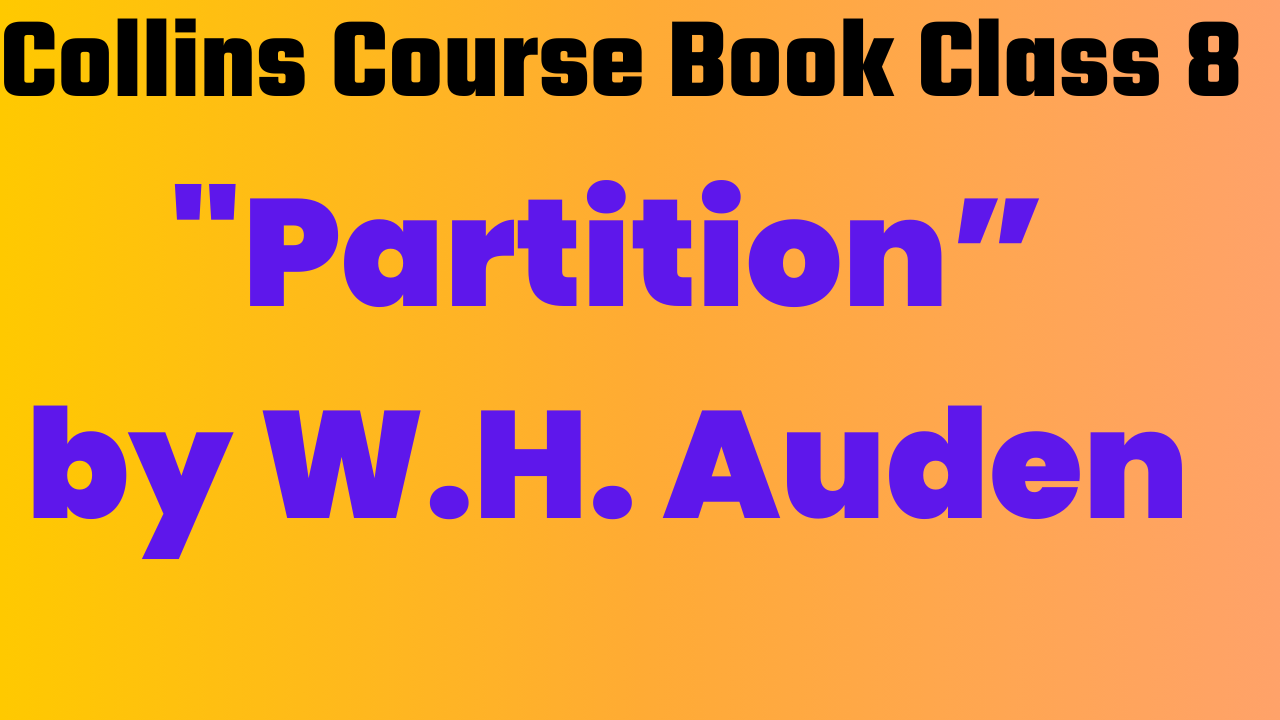#Cyril Radcliffe #British #boundaries #maps #Hindu and Muslim
In this post, I am sharing with Partition Poem composed by W.H Auden with summary, analyze and with all answers from the book Collins chapter 3. Besides this chapter, you can get Chapter 1 Partition, and Chapter 2 Incredible Journey……..
and if you want Sad Shayri Images in Hindi In HD quality 2023 click here
Collins class 8 “Chapter 3 Partition”
Summary
The Poem entitled “Partition” composed by W.H. Auden examines the life and times of the British barrister,
Cyril Radcliffe, who was entrusted with the crucial task of outlining the boundaries during the partition of India in 1947. The most important or difficult part of the problem was that Radcliffe was chosen primarily for his impartiality as he had never set foot in India before and had no interference whatsoever in the ongoing conflict between the Hindu and Muslim communities. However, the British administration provided him with a remarkably short timeline and absolutely no hope of reaching an agreement between both communities Radcliffe was furnished with the aid of two Hindu and two Muslim judges to assist him, yet he ultimately had the final say in the apportioning of India.
Radcliffe was secluded in a grand mansion and heavily guarded to protect him from assassination attempts. He was handed outdated maps and inaccurate census data to work with. The sweltering heat, coupled with an episode of dysentery, made his task all the more difficult. Nonetheless, he managed to accomplish his mission within a span of seven weeks and immediately left for England the very next day. The poem critics on the British’s lackadaisical attitude towards the partition which impacted millions of lives. In addition, it examines how colonialism enabled foreigners to make decisions about cultures and societies with which they were unfamiliar.
A. Read the lines from the poem and answer the questions.
1. Unbiased at least he was when he arrived on his mission,
Having never set eyes on this land he was called to partition
- Who is the poet talking about?
Answer: The poet is talking about Cyril Radcliffe, a British lawyer who was assigned to draw the boundaries during the 1947 Partition of India.
- What was this person’s mission?
Answer: Cyril Radcliffe’s mission was to partition India, as assigned by the British government.
2. He got down to work, to the task of settling the fate
Of millions. The maps at his disposal were out of date
- What work did he get down to?
Answer: Cyril Radcliffe got down to the task of settling the fate of millions by drawing the boundaries for the Partition of India.
- What was wrong with the maps?
Answer: The maps that Cyril Radcliffe had at his disposal were out of date, which means they were not updated with the latest information.
3. But in seven weeks it was done, the frontiers decided,
A continent for better or worse divided.
- What was done in seven weeks?
Answer: In seven weeks, Cyril Radcliffe completed the task of drawing the boundaries for the Partition of India.
b. What happened after ‘it was done’?
Answer: After the task was completed, a continent was divided for better or worse.
B. Answer the questions briefly.
1. How have the two sets of people been described in the poem?
Answer: The two sets of people in the poem are the Hindu and Muslim populations.
2. What was Radcliffe told before he came to India?
Answer: Radcliffe was told to draw the boundaries during the 1947 Partition of India.
3. What would the lines drawn by him decide?
Answer: The lines drawn by Radcliffe would decide the division of India.
4. How did Radcliffe find the weather? What happened as a result?
Answer: Radcliffe found the weather extremely hot, which caused him to suffer from dysentery.
5. Where did Radcliffe go back to? Did he remember what he had done once he left?
Answer: Radcliffe went back to England the day after completing the task. It is not specified in the poem whether he remembered what he had done.
C. Think and answer the questions.
1. What does the phrase ‘at least’ in the first line suggest? What does it hint about the rest of the British in India? Give reasons for your answer.
Answer: The phrase “at least” in the first line suggests that despite the British government’s lack of concern and care in appointing Radcliffe, they made a good decision in choosing someone who was unbiased and had no previous ties to India. It hints at the incompetence and lack of understanding of the British government regarding the complex situation in India, and their disregard for the consequences of their actions.
2. Do you think that the poet was happy the way India was divided into two parts? Explain by quoting from the poem.
Answer: The poet’s attitude towards the division of India is critical and negative. The poem highlights the lack of concern and care the British showed in making a decision that affected millions of people, and critiques the colonialism that allowed outsiders to make decisions for cultures they did not fully understand. The line “A continent for better or worse divided” suggests that the division was not a positive outcome, and the poet is critical of the British for making such a decision without fully understanding the consequences.
#Cyril Radcliffe #British #boundaries #maps #Hindu and Muslim
